
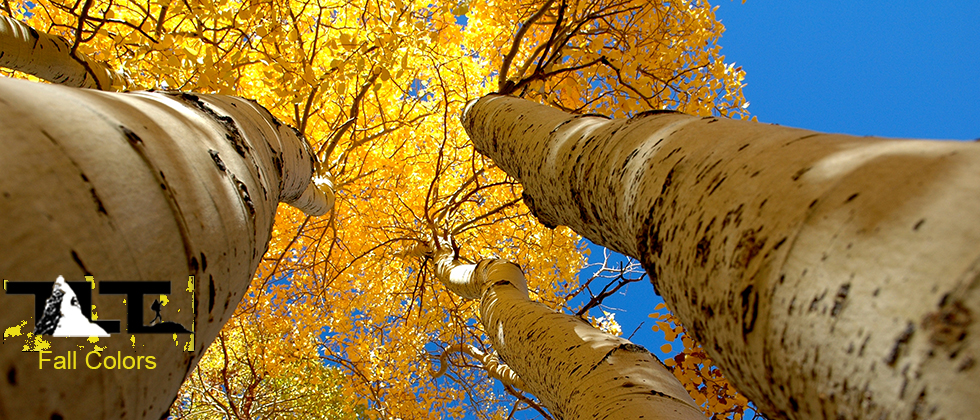 THE SEASON OF FALL is hard to beat when is comes to color and exquisite natural beauty. My wife and I always try and venture out to key locations throughout the United States so that we can enjoy this most special time of year. But what causes this magnificent change of color during Autumn? Well, to answer this question, we have to get just a bit technical for a moment.
THE SEASON OF FALL is hard to beat when is comes to color and exquisite natural beauty. My wife and I always try and venture out to key locations throughout the United States so that we can enjoy this most special time of year. But what causes this magnificent change of color during Autumn? Well, to answer this question, we have to get just a bit technical for a moment.
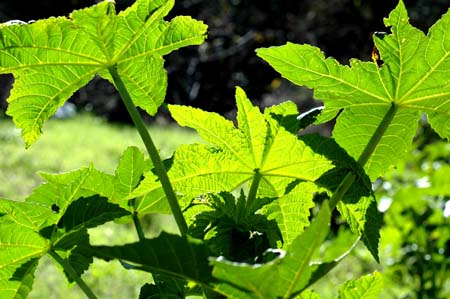 The green pigment in leaves is chlorophyll. Chlorophyll absorbs red and blue light from the sunlight that falls on
leaves. Therefore, the light reflected by the leaves is diminished in the reds and blues and appears green. The
molecules of chlorophyll are large and are not soluble in the watery solution that fills plant cells. Instead, they are attached to the membranes of the disc-like structures called chloroplasts inside the cells. Chloroplasts are the site of photosynthesis. Photosynthesis is the process in which light energy is converted to chemical energy. Chloroplasts are like mini factories inside the plant.
The green pigment in leaves is chlorophyll. Chlorophyll absorbs red and blue light from the sunlight that falls on
leaves. Therefore, the light reflected by the leaves is diminished in the reds and blues and appears green. The
molecules of chlorophyll are large and are not soluble in the watery solution that fills plant cells. Instead, they are attached to the membranes of the disc-like structures called chloroplasts inside the cells. Chloroplasts are the site of photosynthesis. Photosynthesis is the process in which light energy is converted to chemical energy. Chloroplasts are like mini factories inside the plant. Light is the power source for this factory, and this energy is absorbed by chlorophyll which is used by the plant to transform carbon dioxide and water into oxygen and carbohydrates (sugars and starches). This chemical energy drives the biochemical reactions that cause plants to grow, flower, and produce seed. Chlorophyll is not a very stable compound and bright sunlight will cause it to decompose. To maintain the amount of chlorophyll in their leaves, plants continuously synthesize it. The synthesis of chlorophyll in plants requires sunlight and warm temperatures. This is why during summer months, chlorophyll is continuously broken down and regenerated in the leaves of plants and trees.
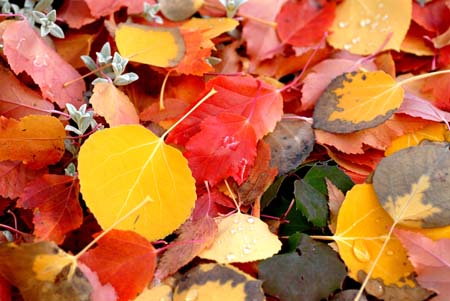 Sunlight
Sunlight As the days grow shorter and nights grow longer, biochemical processes in the leaf begin to paint the landscape with the beautiful colors of autumn. As mentioned above, the amount of sunlight has a direct influence on what goes on inside the plants mini factories. When the amount of sunlight decreases (during the fall season) things begin to change not only on the inside of the plant or tree, but also on the outside. Therefore, what you see on the outside is really an inside job.
Chlorophyll is not the only chemical substance at work. We also have two other pigments that are subdued during the other seasons that burst forth during autumn. We have the carotenoids, which produce yellow, orange, and brown colors in such things as corn, carrots, and daffodils, as well as rutabagas, buttercups, and bananas. And we also have the anthocyanins, which give color to such familiar things as cranberries, red apples, concord grapes, blueberries, cherries, strawberries, and plums. They are water soluble and appear in the watery liquid of leaf cells. As night length increases in the autumn, chlorophyll production slows down and then stops and eventually all the chlorophyll is destroyed. The carotenoids and anthocyanins that are present in the leaf are then unmasked and show their colors.
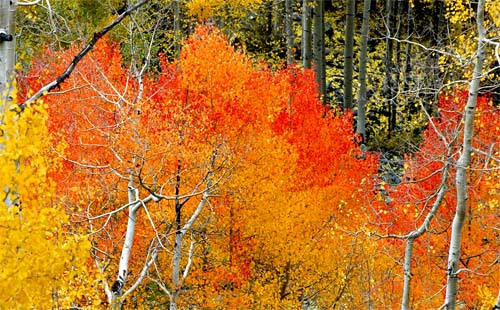 Temperature and Moisture
Temperature and Moisture Diminishing sunlight is what triggers fall's display of colors, but temperature and moisture have a profound effect on the brilliance of these colors. A succession of warm sunny days, and cool crisp (but not freezing) nights, seem to bring about the most spectacular displays. The anthocyanin's as mentioned above are responsible for the brilliant reds, crimsons, and purples. But it takes lots of sugars along with warm daytime temperatures and cool nights to bring out the best of these tints. The light during the day insures sugar production, and the cool of the night causes the closing down of the leaves veins. This process traps the sugars in the leaf and produces the perfect conditions for the anthocyanins to come into the forefront. This in turn will produce the magnificent reds, crimsons and purples that so many people love to view during the fall season.
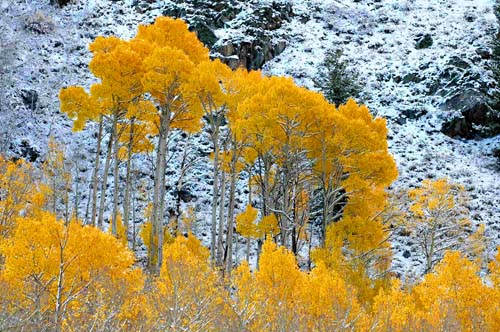 Carotenoids are always present in leaves, therefore, yellow and gold colors remain fairly constant from year to year. Freezing conditions during autumn on the other hand will cut the fall colors short. The photo on the right displays an early snow fall in Bishop Creek Canyon in the Sierra Nevada Mountains. Needless to say, it was shortly afterward that the aspens dropped their leaves. In the meantime, the snowy background provided for excellent photo opportunities as the aspens
displayed their beautiful golden colors against this cold white back drop.
Carotenoids are always present in leaves, therefore, yellow and gold colors remain fairly constant from year to year. Freezing conditions during autumn on the other hand will cut the fall colors short. The photo on the right displays an early snow fall in Bishop Creek Canyon in the Sierra Nevada Mountains. Needless to say, it was shortly afterward that the aspens dropped their leaves. In the meantime, the snowy background provided for excellent photo opportunities as the aspens
displayed their beautiful golden colors against this cold white back drop. But whether winter comes early or not, eventually the broad leaved plants (and trees such as the aspen) will drop their leaves as colder temperatures set in. This is because the fluid in the above mentioned leaves consists of a watery sap that freezes easily. The leaves must then be shed in order to ensure the survival of the plant during the coming winter months.
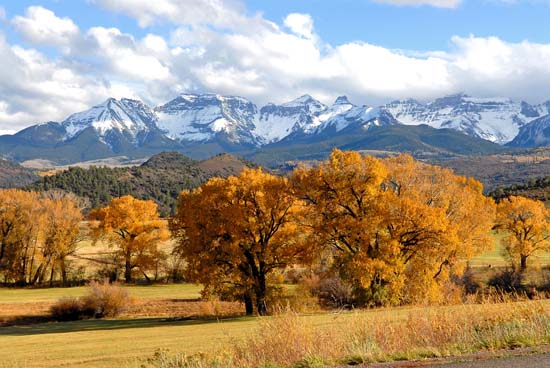 The amount of moisture in the soil also affects autumn colors. Both soil moisture and weather can vary greatly from year to year. The countless combinations of these two highly variable factors assure that no two autumns will be exactly alike. A late spring, or a severe summer drought, can delay the onset of fall color by a few weeks. A warm period during fall will also lower the vibrancy of autumn colors. A warm moist spring along with favorable summer weather, and warm sunny fall days with cool nights should produce the most brilliant autumn colors. The cottonwood trees shown to the left are very affected by moisture. They grow 40 to 80 feet in height and have a broad open crown of widely spreading branches. Cottonwoods are widely grown for timber production along wet river banks, where their exceptional growth rate provides a large crop of wood within just 10-30 years. The wood is coarse and of fairly low value, used for pallet boxes, shipping crates and similar, where a coarse but cheap and strong wood is suitable.
The amount of moisture in the soil also affects autumn colors. Both soil moisture and weather can vary greatly from year to year. The countless combinations of these two highly variable factors assure that no two autumns will be exactly alike. A late spring, or a severe summer drought, can delay the onset of fall color by a few weeks. A warm period during fall will also lower the vibrancy of autumn colors. A warm moist spring along with favorable summer weather, and warm sunny fall days with cool nights should produce the most brilliant autumn colors. The cottonwood trees shown to the left are very affected by moisture. They grow 40 to 80 feet in height and have a broad open crown of widely spreading branches. Cottonwoods are widely grown for timber production along wet river banks, where their exceptional growth rate provides a large crop of wood within just 10-30 years. The wood is coarse and of fairly low value, used for pallet boxes, shipping crates and similar, where a coarse but cheap and strong wood is suitable. Cottonwoods are not limited to wet river banks, but also will grow where ever there are wet soil conditions. As seen in the image above, cottonwoods can produce beautiful fall colors during season. But as mentioned above, soil moisture plays a large role in the brilliancy of colors from year to year. Contrasting scenes show how evergreens such as the pine trees in the above image to the left maintain their green colors all year round, while the aspen grove to the right turns a golden yellow and then drops it's leaves.
 The evergreens-pines (shown in the above photo to the left), spruces, cedars, firs, and so on-are able to survive winter
because they have needle-like or scale-like foliage that is covered with a heavy wax coating. This sticky substance can be
found all over in pine forests, and has been the culprit in attaching itself to my clothing on several backpacking outings. This sticky fluid inside the evergreens cells contains a substances that resists freezing. The foliage of the evergreens can stand up to all but the most severe of winters. But even the evergreen needles will eventually fall, because of the ravages of time. But the needles and leaves that fall to the ground are not wasted. They decompose and replenish the soil with nutrients that make up the spongy humus layer of the forest floor. This layer is very important, because it absorbs and holds rainfall which is essential for life in the forest. Fallen leaves also become food for countless soil organisms that are vital to the forest ecosystem.
The evergreens-pines (shown in the above photo to the left), spruces, cedars, firs, and so on-are able to survive winter
because they have needle-like or scale-like foliage that is covered with a heavy wax coating. This sticky substance can be
found all over in pine forests, and has been the culprit in attaching itself to my clothing on several backpacking outings. This sticky fluid inside the evergreens cells contains a substances that resists freezing. The foliage of the evergreens can stand up to all but the most severe of winters. But even the evergreen needles will eventually fall, because of the ravages of time. But the needles and leaves that fall to the ground are not wasted. They decompose and replenish the soil with nutrients that make up the spongy humus layer of the forest floor. This layer is very important, because it absorbs and holds rainfall which is essential for life in the forest. Fallen leaves also become food for countless soil organisms that are vital to the forest ecosystem.
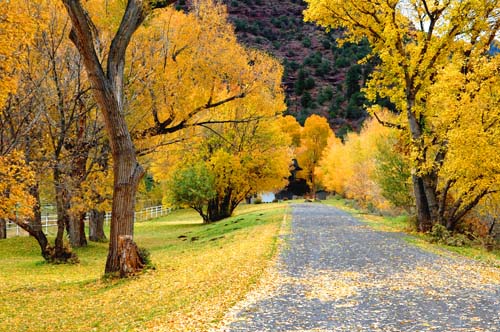 Autumn Photography
Autumn PhotographyCreating lasting memories during the fall season is one of the most satisfying pleasures for the outdoor photographer. During peak autumn season, you will see them lined up with their tripods clicking away in hopes of capturing that award winning image. But no matter if you are a professional photographer, a serious amateur, or just out to have fun with your point and shoot, fall colors have something to offer everyone.
Even though it is hard to miss getting a beautiful photo during autumn, there are some things that you can do to maximize your success rate. First of all, try and get off the beaten path. The scene to the left is a little roadway off the main highway that few people bother with. Most photographers just whiz by this photo opportunity. Little lanes such as this have a beauty all their own, and project not only the beauty of the season, Cottonwoods lining a small roadway near Ouray, Colorado but the peacefulness that goes with it.
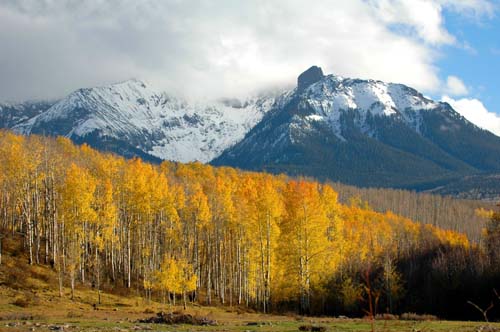 Next, be sure to make good use of your telephoto lenses. They are able to capture distant photos as seen to the left, above, and compress the wonderful aspen forest against the majestic white snow capped mountains in the background. Lighting and contrast is what photography is all about, so getting up early to capture the early morning light, or staying out later to capture the setting sun will ensure that you get the most out of your equipment. So make use of these magical hours of the day. Notice how the aspens in the foreground have already lost their leaves. Autumn colors go fast at high altitude so their is no time to loose if you want to capture photos like this.
Next, be sure to make good use of your telephoto lenses. They are able to capture distant photos as seen to the left, above, and compress the wonderful aspen forest against the majestic white snow capped mountains in the background. Lighting and contrast is what photography is all about, so getting up early to capture the early morning light, or staying out later to capture the setting sun will ensure that you get the most out of your equipment. So make use of these magical hours of the day. Notice how the aspens in the foreground have already lost their leaves. Autumn colors go fast at high altitude so their is no time to loose if you want to capture photos like this.
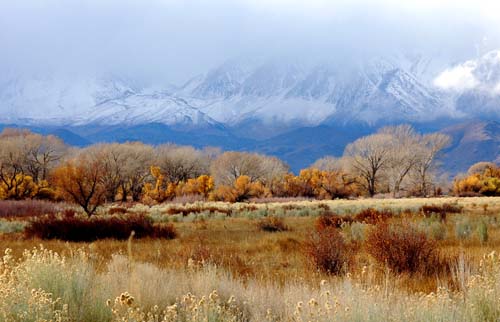 The photo shown to the right above was taken on the floor of the Owens Valley in California, at the base of the Sierra Nevada. The Owens Valley consists of high desert like vegetation and most people would never think of fall photo opportunities there. I almost missed photographing the picture to the right myself. After taking some photos at a local museum I just happened to stumble on the scene to the right. I simply got out of my vehicle and took what I thought to be just a casual snapshot. Little did I know that it would turn out to be my best photo of the day. The mighty fog laden Sierra Nevada Mountains in the background along with the multi-layering of fall colors in the foreground all cametogether and created a wonderful photographic image.
The photo shown to the right above was taken on the floor of the Owens Valley in California, at the base of the Sierra Nevada. The Owens Valley consists of high desert like vegetation and most people would never think of fall photo opportunities there. I almost missed photographing the picture to the right myself. After taking some photos at a local museum I just happened to stumble on the scene to the right. I simply got out of my vehicle and took what I thought to be just a casual snapshot. Little did I know that it would turn out to be my best photo of the day. The mighty fog laden Sierra Nevada Mountains in the background along with the multi-layering of fall colors in the foreground all cametogether and created a wonderful photographic image.
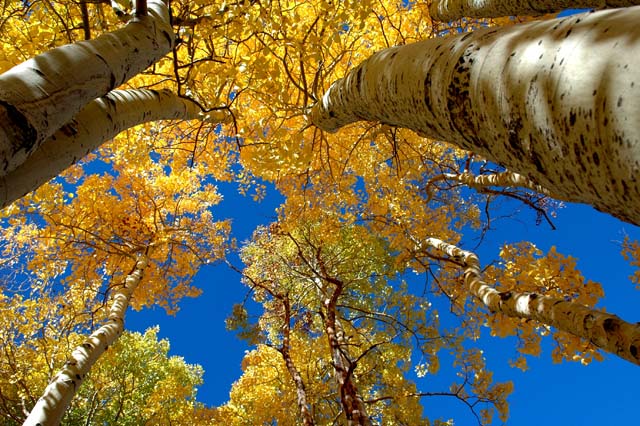 The photo shown to the left above was taken at near ground level with a wide angle lens. The expanded view created a dramatic perspective by showing the bulk of the aspens white bark in contrast with the beautiful canopy above. The sun being in
the near 12 O-Clock position was perfect for this photo.
The photo shown to the left above was taken at near ground level with a wide angle lens. The expanded view created a dramatic perspective by showing the bulk of the aspens white bark in contrast with the beautiful canopy above. The sun being in
the near 12 O-Clock position was perfect for this photo.Back lighting brings out the brilliance of autumn colors and the photographic results will dazzle your viewers. I can tell you first hand that as pretty as this picture may appear on the Internet, it can't even compare to an actual blow up on fine photographic paper. So do not be afraid to try all sorts of camera angles and positions. The results will be well worth the effort.
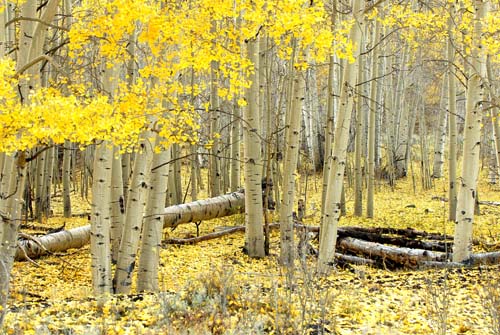 The next tip involves getting out of you vehicle and taking a walk. In our sedentary society few people ever take the time to go out an explore the great outdoors. Because I have a long vehicle I most often have to take the furthest parking space from my destination. But I can't tell you how many times after parking I have reached the store front and began to do my shopping while people continue to go around and around in the parking area looking (or waiting) to get a closer spot so they do not have to walk that few extra steps. The beautiful golden aspen photo to the right above was acquired by getting out of the vehicle and taking a walk. If I would have stood at my vehicle and taken a photo from there, all you would see in
the image would be an empty beer can on the side of the road along with a bit of dry brush. Almost every photograph in this site was a result of putting in some extra effort (sometimes a whole lot of it).
The next tip involves getting out of you vehicle and taking a walk. In our sedentary society few people ever take the time to go out an explore the great outdoors. Because I have a long vehicle I most often have to take the furthest parking space from my destination. But I can't tell you how many times after parking I have reached the store front and began to do my shopping while people continue to go around and around in the parking area looking (or waiting) to get a closer spot so they do not have to walk that few extra steps. The beautiful golden aspen photo to the right above was acquired by getting out of the vehicle and taking a walk. If I would have stood at my vehicle and taken a photo from there, all you would see in
the image would be an empty beer can on the side of the road along with a bit of dry brush. Almost every photograph in this site was a result of putting in some extra effort (sometimes a whole lot of it).
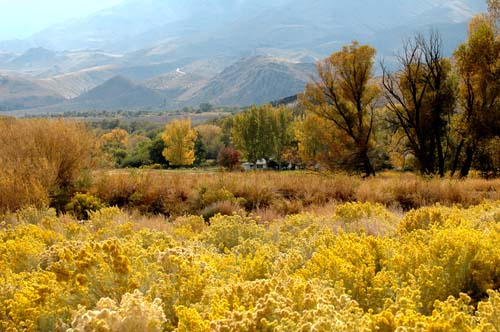 Also, try and visit places during the fall that you would never suspect to provide color. During the summer months, the photo to the left, above, would just be a dried out jumble of brown looking weeds. But in the fall season, the normally dirty brown Golden Rod takes on a whole different image. What normally would be something you would never think of photographing may become a beautiful scene during the autumn months.
Also, try and visit places during the fall that you would never suspect to provide color. During the summer months, the photo to the left, above, would just be a dried out jumble of brown looking weeds. But in the fall season, the normally dirty brown Golden Rod takes on a whole different image. What normally would be something you would never think of photographing may become a beautiful scene during the autumn months.Galen Rowell (a world class photographer) did some of his most spectacular work in the Owens Valley below the Sierra Nevada in California by taking advantage of the beautiful forground colors of the Golden Rod which is plentiful in an otherwise desert landscape during the Autumn months. Galen Rowell passed away along with his wife Barbara, pilot Tom Reid and his Reid's friend Carol McAffee in August of 2002 when their plane crashed in Inyo County near Bishop California. Certainly a very sad tragedy but Galen's work as a photographer and writer lives on.
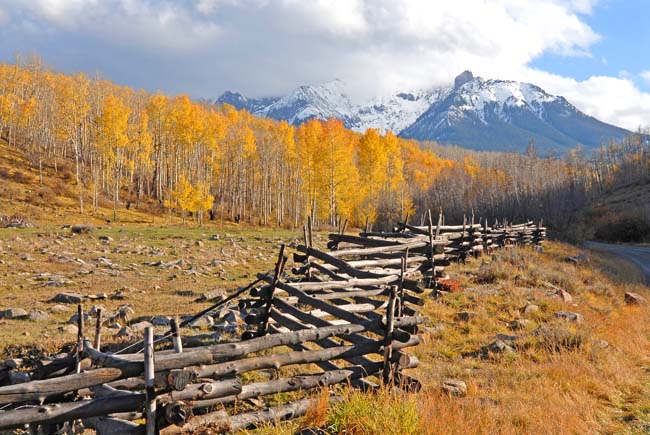 And Finally, there is that well worn path. The familiar image to the right above was taken at the Dallas Divide in the Colorado San Juan mountains. The buck and rail fence in the foreground along with the aspens in the middle ground, and the mountains in the rear make for dramatic layering. And don't forget, (as mentioned above), that no two fall seasons are alike. This makes it possible for you to get that unique award winning image out of that familiar landscape. (On a side note, I always wondered why ranchers went to all that trouble to build buck and rail fences (as shown to the right), until I discovered that they did so, in order to avoid even more work by having to dig post holes in the rock hard soil of the San Juan's and Rocky Mountains.)
And Finally, there is that well worn path. The familiar image to the right above was taken at the Dallas Divide in the Colorado San Juan mountains. The buck and rail fence in the foreground along with the aspens in the middle ground, and the mountains in the rear make for dramatic layering. And don't forget, (as mentioned above), that no two fall seasons are alike. This makes it possible for you to get that unique award winning image out of that familiar landscape. (On a side note, I always wondered why ranchers went to all that trouble to build buck and rail fences (as shown to the right), until I discovered that they did so, in order to avoid even more work by having to dig post holes in the rock hard soil of the San Juan's and Rocky Mountains.)
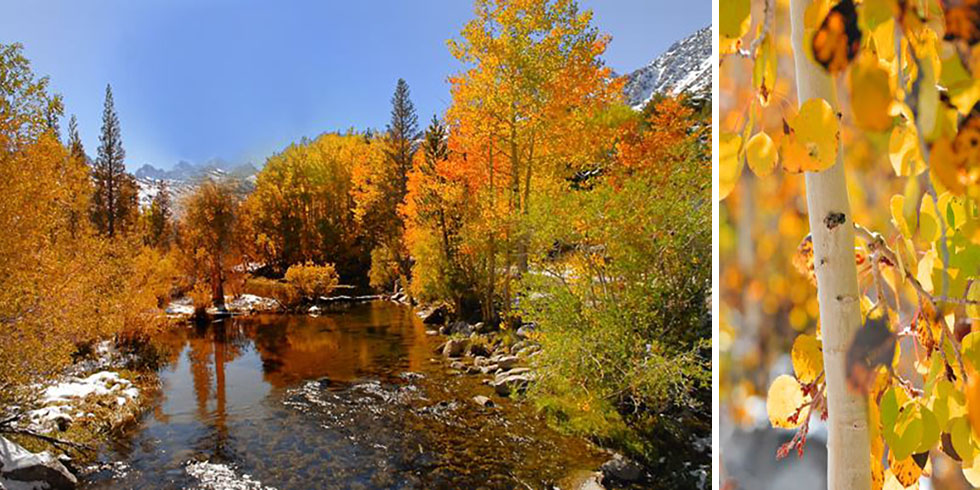 Well, that's about it for Fall Colors at Timberline Trails. We certainly enjoyed sharing with you and hope that you have gained something from your visit here.
Well, that's about it for Fall Colors at Timberline Trails. We certainly enjoyed sharing with you and hope that you have gained something from your visit here.
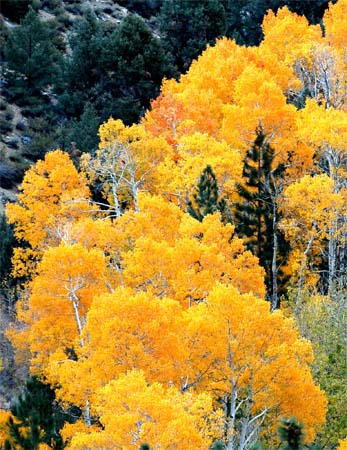 Deeper Insight
Deeper InsightGod has created so much beauty here on earth and we can learn so much from it for, "The earth is the Lord's, and everything in it." (1st Corinthians 10:26) But during fall season, each leaf that falls to the ground will not be in vain, because it will supply essential nutrients for the life that will follow. Jesus often used nature to explain heavenly principles, and in the Gospel of John, Jesus explains one of these important parables by using an example that is similar to the one we described above. It reads as follows: Jesus replied, "The hour has come for the Son of Man to be glorified. I tell you the truth, unless a kernel of wheat falls to the ground and dies, it remains only a single seed. But if it dies, it produces many seeds. (John 12:23-24) Jesus, of course, is talking about Himself here. He is anticipating His own sacrificial death on the cross where He will take upon Himself the sins of the world. Jesus portrays Himself as the kernel of wheat in the above verse, and we are the many seeds that follow. To find out more about the existence of God and His plan for you, please visit the following links: The Ultimate Journey and/or Just Stop and Think
Email Sign Up
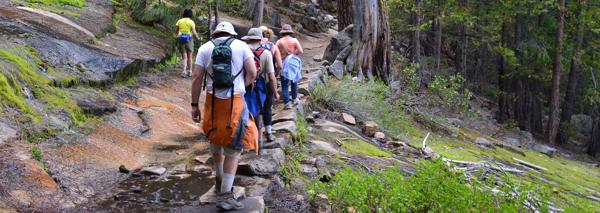
| Join the Adventure! Sign up here for Timberline Trails Monthly Newsletter |

Join us on Instagram

©2006-2024 TimberlineTrails. All Rights Reserved.
....